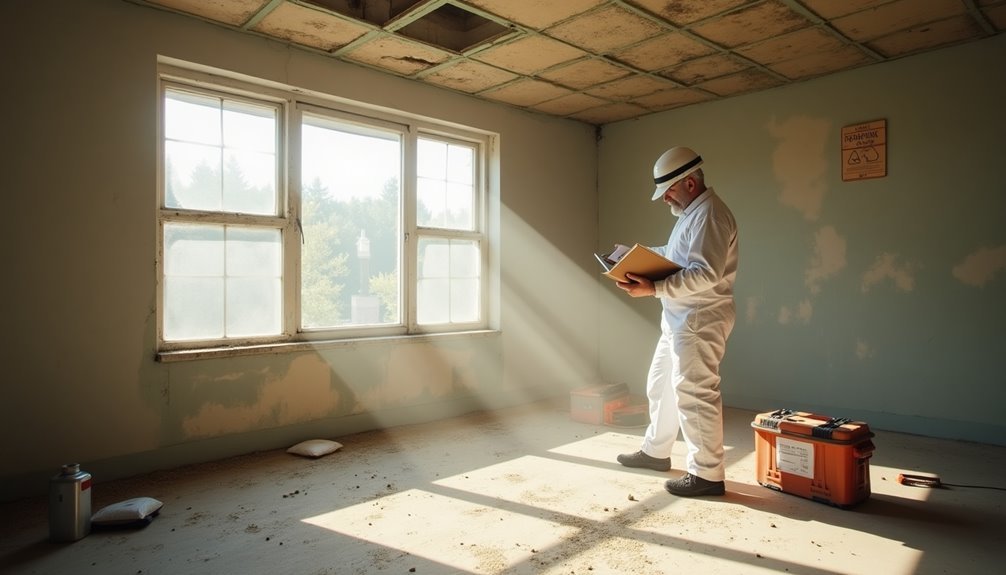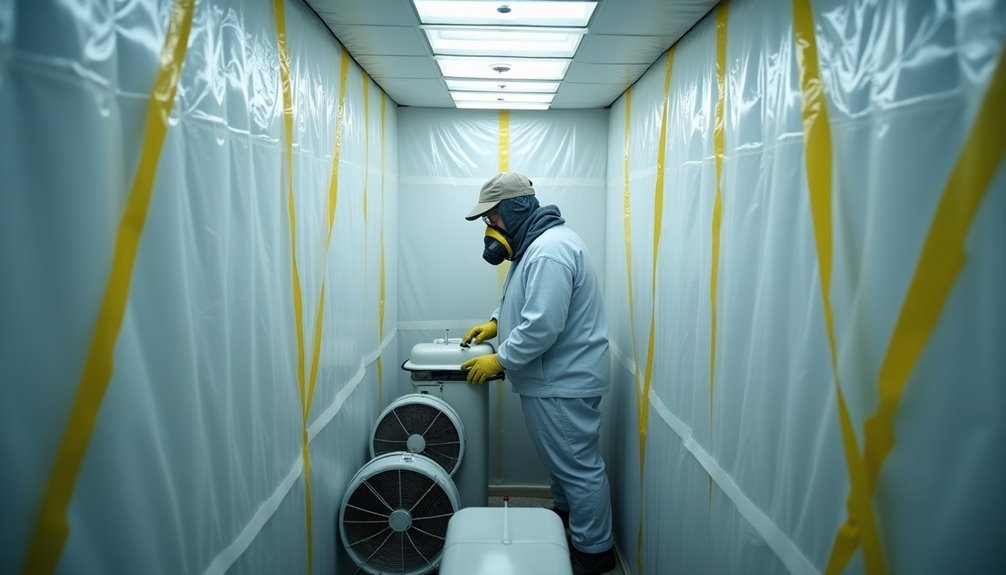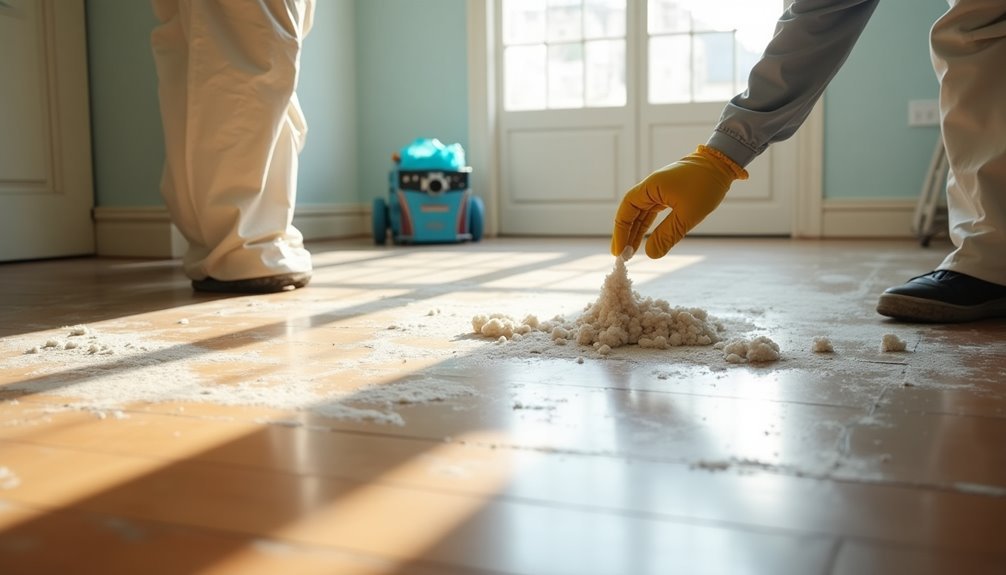Asbestos abatement involves a thorough process to safely remove or manage hazardous asbestos materials in your environment. First, you'll need an inspection to assess any potential asbestos-containing materials. After that, you prepare by defining the project scope and gathering necessary equipment. The area is then contained to prevent fiber spread. Your team will either remove or encapsulate the asbestos. Following removal, thorough cleanup and air testing ensure safety before occupancy. Finally, you must dispose of asbestos waste responsibly. Each step requires strict adherence to regulations and best practices, leading to a safer environment for everyone involved. Further details await you.
Inspection and Assessment

When tackling asbestos abatement, the first step is to conduct a thorough inspection and assessment of the building. You'll start by reviewing the building's history to pinpoint potential asbestos-containing materials. Engaging with occupants and maintenance staff can provide invaluable insights. A detailed visual inspection of accessible areas follows, focusing on ceilings, walls, and flooring to identify probable asbestos sources.
Utilizing effective asbestos identification techniques is crucial. You'll collect samples from suspected materials, sending them to accredited labs for analysis. Initial identification often employs phase contrast polarized light microscopy (PLM), while more intricate analysis utilizes transmission electron microscopy (TEM) and scanning electron microscopy (SEM). Additionally, understanding the health risks associated with asbestos exposure is essential to inform occupants about potential dangers during the abatement process.
Documentation of your findings is vital for risk assessment methods. This allows you to assess the condition of materials and decide on further actions. Look for previous abatement efforts, as this can influence your risk evaluation. By systematically identifying areas with a high probability of asbestos presence, you not only ensure safety but also empower yourself and others in the liberation from toxic environments. This meticulous approach sets the groundwork for effective abatement strategies.
Preparation and Planning
Preparation and Planning
After completing the inspection and assessment, the next phase involves preparation and planning for the asbestos abatement project. This stage is crucial for ensuring a smooth operation and minimizing risks. You'll need to define the project scope, evaluate the complexity, and conduct a thorough risk assessment to inform your approach.
Here are three essential steps to consider:
- Establish a Project Timeline: Set clear deadlines for each phase of the abatement process, ensuring that all team members are aware of their roles and responsibilities.
- Identify Safety Measures: Outline necessary personal protective equipment (PPE) and ensure all workers are trained and certified in asbestos removal. This will help you adhere to federal and state regulations. Additionally, it's important to implement proper PPE for staff to further enhance safety during the abatement.
- Gather Required Equipment: Assemble tools such as HEPA vacuum systems, sealed hazardous waste containers, and air quality monitoring devices to maintain a safe work environment.
Containment Setup

Setting up containment is critical for effective asbestos abatement, as it prevents the spread of hazardous fibers during the removal process. You'll begin by sealing off the work area with plastic sheeting, which acts as the first line of defense. Implementing containment strategies like these ensures that airborne fibers remain contained.
Next, you'll use negative pressure units to create an airflow that draws air into the containment area while preventing it from escaping. This setup traps any released fibers within the designated zone. High-efficiency particulate air (HEPA) filters are essential to capture any fibers that may escape into the air.
Don't forget to mark the entrances with caution signs, warning others about potential asbestos hazards. It's also crucial to seal HVAC systems to stop fiber dispersal throughout the building.
A thorough site assessment will help identify asbestos-containing materials, allowing you to create a regulated area for safe removal. By following these steps, you'll ensure that the containment setup is robust and effective, setting the stage for a successful abatement process.
Removal or Encapsulation
Asbestos abatement encompasses two primary approaches: removal and encapsulation, each tailored to specific circumstances. When dealing with asbestos, you'll need to understand the methods at your disposal.
- Removal Techniques: This involves carefully extracting asbestos-containing materials from the site using hand tools and wet methods to minimize fiber release. Workers wear protective gear to ensure safety, and the materials are sealed in special disposal bags before being taken to a decontamination unit.
- Encapsulation Methods: Instead of removing asbestos, encapsulation seals the asbestos material to prevent fiber release. This can be done through painting, spraying coatings, or covering with non-asbestos materials. Additional protective layers might include cladding or resins.
- Regulatory Compliance: Regardless of the chosen approach, all work must adhere to local, state, and federal regulations. Proper disposal of asbestos waste is critical; it must be sealed, labeled, and taken to licensed landfills.
Choosing between removal and encapsulation depends on the condition of the asbestos material and your specific needs. Each method aims to ensure safety and compliance, protecting you and others from potential exposure.
Post-Removal Cleanup

After asbestos removal, you must conduct a thorough cleaning of the work area to eliminate any remaining fibers. This involves using HEPA vacuums and wet methods to ensure that surfaces are free from contamination. Following this, air quality testing is essential to confirm that asbestos levels comply with safety regulations before declaring the area safe for re-entry.
Thorough Area Cleaning
Thorough area cleaning is a critical step in the post-removal process, ensuring that all traces of asbestos are eliminated from the affected environment. This stage involves meticulous procedures to safeguard your health and the safety of others. Here's what you can expect:
- HEPA Vacuum Usage: Specialized HEPA-filtered vacuums are employed to gather even the smallest asbestos particles, ensuring minimal dispersal of dangerous fibers. The entire containment area is vacuumed thoroughly, targeting microscopic remnants.
- Wet Cleaning Methods: Wet cleaning techniques are utilized to wipe down all surfaces, ceilings, and floors. This method prevents asbestos fibers from becoming airborne, allowing for a comprehensive removal of dust and debris.
- Decontamination of Equipment: All tools and equipment must be meticulously cleaned or disposed of according to safety regulations. This step is crucial to prevent contamination in other areas and to ensure that no asbestos materials linger.
Air Quality Testing
Following the successful removal of asbestos, air quality testing becomes essential to ensure the safety of the environment. This process involves several stages, including reassurance air testing and clearance air testing, both critical for confirming that airborne contaminants have been adequately addressed.
Reassurance air testing occurs immediately after asbestos has been disturbed or removed. Using a sampling pump, a known volume of air is pulled through a filter, allowing for fiber analysis. The results must show less than 0.01 fibers per milliliter of air to deem the area safe for reoccupation.
Clearance air testing is part of a four-stage clearance process and requires sampling at least 480 liters of air. A third-party certified air sampler conducts this test to ensure impartial results. Like reassurance testing, it involves analyzing air samples for asbestos fibers, with successful clearance also indicated by levels below 0.01 fibers per milliliter.
Both testing procedures utilize high-efficiency particulate air (HEPA) vacuums and phase contrast microscopy for accurate fiber count. These measures ensure the environment is safe and compliant with health standards, allowing you to regain peace of mind.
Disposal and Clearance
Once you've completed the post-removal cleanup, you must focus on the proper disposal of asbestos waste. This involves placing the materials in leak-tight, labeled containers before transporting them to certified landfills, all while adhering to strict regulations. Additionally, clearance testing is essential to ensure that the work area meets safety standards before dismantling containment barriers.
Asbestos Waste Disposal
Asbestos waste disposal is a critical process that requires strict adherence to safety and regulatory protocols to prevent environmental contamination and health risks. Understanding the steps involved in proper waste management ensures compliance with asbestos regulations and protects public health. Here's what you need to know:
- Preparation and Packaging: Wet asbestos-bearing materials before removal to prevent fiber release. Seal the waste in two layers of 6-millimeter plastic bags, filling them only halfway, and ensure they're tightly sealed with adhesive tape.
- Transportation: Licensed transporters must carry the asbestos waste to approved disposal sites. A chain-of-custody form is essential, detailing the generator, pickup site, and destination, which must be signed by both the generator and the disposal site operator.
- Disposal at Approved Facilities: Dispose of the waste at specialized landfills that comply with EPA requirements. Ensure no visible emissions during disposal, covering the waste with at least 6 inches of non-asbestos material within 24 hours.
Adhering to these guidelines not only mitigates health risks but also fulfills your responsibility toward effective asbestos waste management.
Clearance Testing Procedures
After safely disposing of asbestos waste, the next step is to ensure that the area is free from any remaining asbestos-containing materials (ACM) through clearance testing. An independent environmental technician conducts a thorough visual inspection, focusing on horizontal, irregular, and hard-to-reach areas. If ACM is detected, the site fails, necessitating further removal or cleaning. Only after passing this inspection can air sampling proceed.
Next, a state-licensed air sampling professional collects air samples using cassettes attached to an electric vacuum pump. This process, which typically lasts about an hour and a half, involves drawing air through an open-face filter. Multiple samples may be taken indoors and outdoors for accurate assessment.
The analysis includes Phase Contrast Microscopy (PCM) and Transmission Electron Microscopy (TEM). While PCM measures total fiber counts, TEM provides a precise evaluation of asbestos fibers. Results are usually reported within six business days, outlining compliance with regulatory standards. If fiber counts exceed limits, additional cleaning and re-sampling are required. Adhering to local and state regulations ensures a safe, liberated environment post-abatement.
Conclusion
In conclusion, navigating the asbestos abatement process can feel like traversing a minefield, but with the right guidance, you can safely emerge on the other side. By understanding each step—from inspection to disposal—you're not just ensuring compliance; you're safeguarding your health and that of others. Remember, this journey requires precision and care, but the peace of mind you gain is worth every effort. Stay informed, stay prepared, and protect your environment with confidence.
